Dattatreya
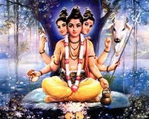
As per "Shripad Shrivallabha Charitra" Dattatreya have 3 Avataras
1) Shripad Shri Vallabha
2) Narasimha Saraswati
3) Akkalkot Swami Samartha Maharaj.
Dattatreya or Datta is a Hindu deity encompassing the trinity of Brahma, Vishnu and Shiva, collectively known as Trimurti. The name Dattatreya can be divided into two words - "Datta" (meaning given) and "Atreya" referring to the sage Atri, his physical father.
Various Hindu sects worship him differently. In the Nath tradition, Dattatreya is recognized as an Avatar or incarnation of Shiva and as the Adi-Guru (First Teacher) of the Adinath Sampradaya of the Nathas. Although Dattatreya was at first a "Lord of Yoga" exhibiting distinctly Tantric traits,[1][2] he was adapted and assimilated into the more devotional (Sanskrit: bhakti) Vaishnavite cults; while still worshiped by millions of Hindus, he is approached more as a benevolent god than as a teacher of the highest essence of Indian thought.
Life
BirthDattatreya was born to the sage Atri, who had been promised by Parameshvara (the Almighty), that He, Parameshvara, would be incarnated as his son.[3] Since Parameshvara subsumes all three members of the trimurti, Dattatreya is at once the incarnation of Vishnu, Shiva and Brahma. This is just one of the many legends related to the birth of Lord Dattatreya.[4] In some he is not Atri's son, but Atri's descendent. Others suggest a more mystical origin of Dattatreya.
Travels
Dattatreya left home at an early age to wander naked in search of the Absolute. He seems to have spent most of his life wandering in the area between and including North Karnataka, through Maharashtra and Andhra Pradesh, and into Gujarat as far as the Narmada River. He attained realization at a town, now known as Ganagapura in Karnataka. The original footprints of Datta are believed to be located on the lonely peak at Girnar. The Tripura-rahasya refers to the disciple Parasurama finding Dattatreya meditating on Gandhamadana mountain.[5]
As an avatarIn The Pathless Path to Immortality, Shri Gurudev Mahendranath writes:
Avatars
Dattatreya incarnation of the Divine Trinity Brahma, Vishnu and Siva and his avatars- Shripad Shri Vallabha, Sri Nrusimha Saraswati and Swami Samarth Maharaj.According to the book "Shridattareya Shodashavatar Charitanee" by Shri Vasudevananda Saraswati, Dattatreya is supposed to have taken 16 Avatars. The names and their birthdate (as per the Lunar calendar) are given in brackets.[11]
1.Yogiraaj (Kaartik Shu.15)
2.Atrivarad (Kaartik Kru.1)
3.Dattatreya (Kaartik Kru.2)
4.Kaalaagnishaman (Maargashirsha Shu.14)
5.Yogijanvallabh (Maargashirsha Shu.15)
6.Lilaavishambhar (Paush Shu.15)
7.Siddharaaj (Maagh Shu.15)
8.Dnyaasaagar (Faalgun Shu.10)
9.Vishambhar (Chaitra Shu.15)
10.Maayaamukta (Vaishaakh Shu.15)
11.Maayaamukta (Jyeshtha Shu.13)
12.Aadiguru (Aashaadh Shu.15)
13.Shivarup (Shraavan Shu.8)
14.Devdev (Bhaadrapad Shu.14)
15.Digambar (Aashwin Shu.15)
16.Krishnashyaamkamalnayan (Kaartik Shu.12)
In the Dasopanta tradition, all 16 are worshiped and Dasopanta is considered as the 17th avatara.
In the Datta Sampradaya the first avatar is Shripad Shri Vallabh and the second is Narasimha Saraswati. Akkalkot Swami Samarth, Shri Vasudevanand Saraswati (Tembe Swami, Sawantwadi)) Manik Prabhu, Krishna Saraswati, Shirdi Sai Baba (Shirdi, Maharashtra), Gajanan Maharaj (Shegaon) and Pujya Sri Ganapathi Sachchidananda Swamiji are also considered as avatars of Dattatreya.[12]
The Upanishads Avadhutopanishad and Jaabaaldarshanopanishad mention that this philosophy was put forward by Dattatreya.
1) Shripad Shri Vallabha
2) Narasimha Saraswati
3) Akkalkot Swami Samartha Maharaj.
Dattatreya or Datta is a Hindu deity encompassing the trinity of Brahma, Vishnu and Shiva, collectively known as Trimurti. The name Dattatreya can be divided into two words - "Datta" (meaning given) and "Atreya" referring to the sage Atri, his physical father.
Various Hindu sects worship him differently. In the Nath tradition, Dattatreya is recognized as an Avatar or incarnation of Shiva and as the Adi-Guru (First Teacher) of the Adinath Sampradaya of the Nathas. Although Dattatreya was at first a "Lord of Yoga" exhibiting distinctly Tantric traits,[1][2] he was adapted and assimilated into the more devotional (Sanskrit: bhakti) Vaishnavite cults; while still worshiped by millions of Hindus, he is approached more as a benevolent god than as a teacher of the highest essence of Indian thought.
Life
BirthDattatreya was born to the sage Atri, who had been promised by Parameshvara (the Almighty), that He, Parameshvara, would be incarnated as his son.[3] Since Parameshvara subsumes all three members of the trimurti, Dattatreya is at once the incarnation of Vishnu, Shiva and Brahma. This is just one of the many legends related to the birth of Lord Dattatreya.[4] In some he is not Atri's son, but Atri's descendent. Others suggest a more mystical origin of Dattatreya.
Travels
Dattatreya left home at an early age to wander naked in search of the Absolute. He seems to have spent most of his life wandering in the area between and including North Karnataka, through Maharashtra and Andhra Pradesh, and into Gujarat as far as the Narmada River. He attained realization at a town, now known as Ganagapura in Karnataka. The original footprints of Datta are believed to be located on the lonely peak at Girnar. The Tripura-rahasya refers to the disciple Parasurama finding Dattatreya meditating on Gandhamadana mountain.[5]
As an avatarIn The Pathless Path to Immortality, Shri Gurudev Mahendranath writes:
Avatars
Dattatreya incarnation of the Divine Trinity Brahma, Vishnu and Siva and his avatars- Shripad Shri Vallabha, Sri Nrusimha Saraswati and Swami Samarth Maharaj.According to the book "Shridattareya Shodashavatar Charitanee" by Shri Vasudevananda Saraswati, Dattatreya is supposed to have taken 16 Avatars. The names and their birthdate (as per the Lunar calendar) are given in brackets.[11]
1.Yogiraaj (Kaartik Shu.15)
2.Atrivarad (Kaartik Kru.1)
3.Dattatreya (Kaartik Kru.2)
4.Kaalaagnishaman (Maargashirsha Shu.14)
5.Yogijanvallabh (Maargashirsha Shu.15)
6.Lilaavishambhar (Paush Shu.15)
7.Siddharaaj (Maagh Shu.15)
8.Dnyaasaagar (Faalgun Shu.10)
9.Vishambhar (Chaitra Shu.15)
10.Maayaamukta (Vaishaakh Shu.15)
11.Maayaamukta (Jyeshtha Shu.13)
12.Aadiguru (Aashaadh Shu.15)
13.Shivarup (Shraavan Shu.8)
14.Devdev (Bhaadrapad Shu.14)
15.Digambar (Aashwin Shu.15)
16.Krishnashyaamkamalnayan (Kaartik Shu.12)
In the Dasopanta tradition, all 16 are worshiped and Dasopanta is considered as the 17th avatara.
In the Datta Sampradaya the first avatar is Shripad Shri Vallabh and the second is Narasimha Saraswati. Akkalkot Swami Samarth, Shri Vasudevanand Saraswati (Tembe Swami, Sawantwadi)) Manik Prabhu, Krishna Saraswati, Shirdi Sai Baba (Shirdi, Maharashtra), Gajanan Maharaj (Shegaon) and Pujya Sri Ganapathi Sachchidananda Swamiji are also considered as avatars of Dattatreya.[12]
The Upanishads Avadhutopanishad and Jaabaaldarshanopanishad mention that this philosophy was put forward by Dattatreya.
Sri Pada Vallabha
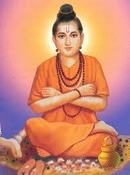
ShriPaadha ShriVallabha (ShriPaadha ShriVallabha) is considered as one of the Avatars (incarnations) of the deity Shri Dattaatreya in kaliyuga. As per some of the experts, he is supposed to have lived from 1320 AD to 1350 AD. He was born in Pitaapuram. Though a sketchy information was available about his life from the book Shri GuruCharithra written by Shri Saraswati Gangadhar in Marathi around 1450 AD, which was later translated in Telugu by Brahmasri Pannala VenkatadriBattu Sarma in Pitaapuram. Later in November 2001, a full book of 53 Chapters on the Life of SripadaVallabha was brought out by a pious devotee by name Malladi Govinda Deekshitulu belonging to the Lineage of Maternal Grandfather of Sripada SriVallabha.
Life Story
Shripada srivallabha was born to Sri Appalaraja Sarma (of Aapastambha Shakha Brahmin) and Sumathi on Bhadrapada Sudha Chavithi ( Ganesh Chaturdi) as the third son of Aappalaraja Sarma and Sumati. His Avataar secrets: When Appalaraja Sarma family was preparing for the shraaddha (a yearly ceremony to pay homage to the departed souls), around noon, some Bhikshuk came for bhiksha. Though custom prevents it but Veda says the one who comes for food at any eating time is none other than Vishnu himself, before feeding the invited Brahmins, she fed this Bhikshuk, considering him as Vishnu. Dattaatreya became quite happy and showed His true self and offered her a boon. She asked for a son "knowledgeable like you" for which Dattaatreya said "yes". Before this, she had many childbirths and none survived, albeir two sons , who were blind and lame respectively. Dattaatreya blessed her by saying that she will have a son who will be a Guru to all. The couple became joyous and within a year they had a son and named Him as 'Shripaada'. It was said that the child had rare holy markings on His soles and feet (Paada). . After spending 3 years at Mahabaleshwar he went to Shri Shaila mountain (Sri Sailam). He spent most of his later life staying in Kuravpur ( Kuravapura ) near Jurala reservoir ( 16.35671, 77.53727 ).
Sri Nrusimha Saraswati
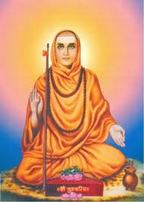
Narasimha Saraswati (1378-1458) is the Purna Avatar of Dattatreya(As per "Shripad Shrivallabha Charitra" he is second avatar of Dattatreya).He was born in Karanjapur which is modern Lad-Karanja or karanja in Maharashtra Vidbaraba region.
Shri Narasimha Saraswati was initially named as Narahari or Shaligramadeva. His father's name was Madhav and mother's name was Amba-Bhavani. His surname was Kale. He was born in a Deshastha Brahmin family Shukla-yajurvedi Brahman Kanva Shaka. At Karanja there is the original house where he was born. Although the house is no longer in the original shape, but still some parts remain and have been converted in to a temple.
Shri GuruCharitra is a book which describe a life of Shri Narasimha Saraswati. The writer of this book is Saraswati Gangadhar, a direct descendant of Saiam Dev. Saiam Dev was one of the major disciples of Shriguru Narasimha Saraswati and was close to the Guruji. As per the presentation in the Guru-Charitra itself, the story of the life of Shriguru Narasimha Saraswati was told to Saraswati Gangadhar by one of the major disciples of the Guruji. Saraswati Gangadhar has presented himself has 'Naam dhaarak' literally meaning one holding or carrying the name (of his Guru).
Life and Work
He left home and went for Kashi-pilgrimage and took Sannyasa at Kashi from Shri Krishna Saraswati. The second part of his name comes from this guru, who eventually named him Shri Narasimha Saraswati. This is a Sanskrit name. Now he became the Guru. After visiting several holy places he returned to Karanja, met his parents. He was possibly of age 30years that time. After that he further visited various places and finally settled in Ganagapur (now in State Karnataka) for the last few decades of his life. All of this is reported in Shri GuruCharitra.
One of the event in his life (towards the end) was the meeting with the Muslim king (Sultan) of Bedar who is possibly Allauddin-II of the Bahamani Sultanate who was ruling that area that time. These rulers were different from the Delhi Mughals and there were four such states which were existing that time. Many times "chahu rashtra" term occurring in
After the meeting with the Muslim king, he thought that his fame has gone to such an extent that now all types of people will start coming in, and will start troubling him and his disciples. Thus he decided to take samadhi. He left for the jungle of Kardali (a type of tree). Shri Swami Samarth of Akkalkot, who is considered as his Avatar, is supposed to have come from Kardali-van (Jungle of Kardali). Although the time difference between them is a few centuries. The Datta-sampradaya people believe that Narasimha Saraswati re-incarnated as Swami Samartha of Akkalkot .
Akkalkot Swami Maharaj
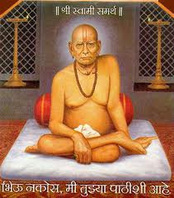
Swami Samarth Maharaj also known as Akkalkot Swami Maharaj) of Akkalkot (died 1878) was an Indian guru of the Dattatreya tradition (sampradaya), widely respected in Maharashtra, Karnataka and Andhra Pradesh. With Shripad Shri Vallabha and Narasimha Saraswati he is often accounted one of three successive reincarnations of Guru Dattatreya.[1] The 'Gurucharitra' gives lot of information about him. On April 30, 1878 (Chaitra Vadya Trayodashi of Hindu year 1800) after nearly 600 years of the incarnation, the great sage adopted MahaSamadhi [the last conscious communion with God] under his favourite Banyan tree.
Devotees still experience his divine presence and feel reassured because of his quote "I HAVE NOT GONE,I AM STILL PRESENT".
Biography
The Swami himself said that he came from the Kardali forest. He reputedly visited places like Puri, Benaras, Hardwar, Girnar, Kathiawad and Rameswaram as well as China, Tibet and Nepal, and stayed at Mangalvedha, a town near Pandharpur in Solapur district, before settling down in Akkalkot.[2] He came to Akkalkot in 1856 at the invitation of Chintopant Tol and stayed there on the outskirts of the town for 22 years. He stayed at Ganagapura, Karnataka for a long time where he delivered the Nirguna Padukas to his disciples and devotees before leaving for the Kardali forest.
It is popularly believed that his predecessor Shri Narasimha Swami went to Kardali and entered samadhi. He remained entranced for three hundred years: an anthill grew over him. One day accidentally a woodcutter cleared the anthill and found the yogi in meditation who resumed his teaching as Swami Samarth.
Gajanan Maharaj
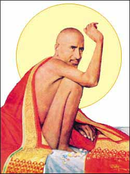
Gajanan Maharaj from Shegaon (Buldhana District), Maharashtra, India is a Saint from India. "Sant Gajanan Maharaj Sansthan" is the largest temple trust in the Vidarbha region.
Shri Sant Gajanan Maharaj, Shegaon.The early life history of Gajanan Maharaj is obscure, his birthdate being unknown. His devotees believe him as incarnation of Lord Ganesha and Lord Dattatreya.[citation needed] Biruduraju Ramaraju has tried to establish in his collection of books called "Andhra Yogulu" that he was a Telangana Brahmin. Some speculate that he might have in fact hailed from Sajjanghad, (which was the place where Sant Samartha had lived). Das Ganu Maharaj has written a 21 chapter biography, "Shri Gajanan Vijay," of Gajanan Maharaj in Marathi. Contemporaries of Gajanan Maharaj identified him by several names like Gin Gine Buwa, Ganpat Buwa, and Awaliya Baba. However, it is amply proved that as a handsome, tall lad of 18 years old he arrived at Akkalkot to meet Shri Swami Samarth. It is said that on seeing him Swami Samarth was overjoyed and made him sit in his lap and caressed him lovingly; people around Samarth who watched this scene sait to Swami that the boy was in his teens and not a child. Thereafter it is said that Swami asked the boy to go to holy place of Kapildhara near Nashik and perform austerities. As per the instructions, the boy performed severe austerities at Kapildhara and attained Atmadnyana and became a Supreme Yogi. Just before his Samadhi, Swami Samarth asked him to get himself 'polished' from Dev Mamaledar (yet another disciple of Swami Samarth and a realized soul) at Nashik. The boy did exactly the same and got blessings of Dev Mamaledar. Later he was asked to keep walking and the place where he stopped would become his Karmabhoomi and the name given by people around him would be his name. This is what happened exactly. After Swami Samarth's samadhi, the boy appeared at Shegaon. The evidence to this story comes from an old man who had seen the boy at Akkalkot with Swami Samarth and had come to Shegaon along with his son who was working in post office and was transferred to Shegaon. Maharaj accepting a human body is a mere pastime (Leela) as he is Brahmadnyani; that is why thousands of the devotees flock to Shegaon for his blessings. How he functions and transforms people from vile, wicked ways to great devotees is really unknown. None in his earthly days ever saw him chanting any special mantra holding japamala etc. But he is a supreme saint, whose blessings everyone must have. According to a legend, a money lender named Bankat Lal Agarwal first saw Gajanan Maharaj in a "superconscious state" on February 23, 1878 on a street. Sensing him to be a saint, Bankat took him home and asked him to stay with him. Legends say that in his lifetime, he performed many miracles such as giving a fresh lease on life to one Janrao Deshmukh, lighting the clay-pipe without fire, filling a dry well with water, drawing sugar cane juice by twisting canes with his hands, and curing leprosy of a woman. He took samadhi on 8 September 1910. A temple in his name is built on his Samadhi at Shegaon.
Head of the Gajanan Maharaj Sansthan-Shivshankarbhau Patil is the head of the trust and well known in India for his administration and management of the temple,bhojan kaksha,engineering and management college, Anand Sagar project and many other institution run by the trust located at Shegaon managed by shri gajanan maharaj sansthan shegaon affiliated to Amravati university. This college is one of the best institutes for engineering education. The Anand Sagar project is also developed by the trust over 650 acres for tourist with all facilities at nominal rates. The temple is famous in Maharashtra for its clean, neat, tidy environment and polite and respectful behaviour of the sevaks of gajanan maharaj trust who works there just for seva.
It is said by Gajanan Maharaj that he will appear again in Domak village (revealed in pothi) of Maharashtra (near Morshi) and his words proved to be true. He again reappeared in Domak village and giving darshan to the devotees since 13 years. Domak Gajanan maharaj looks same as Shegoan Gajanan Maharaj and has performed a lot of miracles in these 13 years. Devotees who seek for his darshan are growing day by day.
Shri Sant Gajanan Maharaj, Shegaon.The early life history of Gajanan Maharaj is obscure, his birthdate being unknown. His devotees believe him as incarnation of Lord Ganesha and Lord Dattatreya.[citation needed] Biruduraju Ramaraju has tried to establish in his collection of books called "Andhra Yogulu" that he was a Telangana Brahmin. Some speculate that he might have in fact hailed from Sajjanghad, (which was the place where Sant Samartha had lived). Das Ganu Maharaj has written a 21 chapter biography, "Shri Gajanan Vijay," of Gajanan Maharaj in Marathi. Contemporaries of Gajanan Maharaj identified him by several names like Gin Gine Buwa, Ganpat Buwa, and Awaliya Baba. However, it is amply proved that as a handsome, tall lad of 18 years old he arrived at Akkalkot to meet Shri Swami Samarth. It is said that on seeing him Swami Samarth was overjoyed and made him sit in his lap and caressed him lovingly; people around Samarth who watched this scene sait to Swami that the boy was in his teens and not a child. Thereafter it is said that Swami asked the boy to go to holy place of Kapildhara near Nashik and perform austerities. As per the instructions, the boy performed severe austerities at Kapildhara and attained Atmadnyana and became a Supreme Yogi. Just before his Samadhi, Swami Samarth asked him to get himself 'polished' from Dev Mamaledar (yet another disciple of Swami Samarth and a realized soul) at Nashik. The boy did exactly the same and got blessings of Dev Mamaledar. Later he was asked to keep walking and the place where he stopped would become his Karmabhoomi and the name given by people around him would be his name. This is what happened exactly. After Swami Samarth's samadhi, the boy appeared at Shegaon. The evidence to this story comes from an old man who had seen the boy at Akkalkot with Swami Samarth and had come to Shegaon along with his son who was working in post office and was transferred to Shegaon. Maharaj accepting a human body is a mere pastime (Leela) as he is Brahmadnyani; that is why thousands of the devotees flock to Shegaon for his blessings. How he functions and transforms people from vile, wicked ways to great devotees is really unknown. None in his earthly days ever saw him chanting any special mantra holding japamala etc. But he is a supreme saint, whose blessings everyone must have. According to a legend, a money lender named Bankat Lal Agarwal first saw Gajanan Maharaj in a "superconscious state" on February 23, 1878 on a street. Sensing him to be a saint, Bankat took him home and asked him to stay with him. Legends say that in his lifetime, he performed many miracles such as giving a fresh lease on life to one Janrao Deshmukh, lighting the clay-pipe without fire, filling a dry well with water, drawing sugar cane juice by twisting canes with his hands, and curing leprosy of a woman. He took samadhi on 8 September 1910. A temple in his name is built on his Samadhi at Shegaon.
Head of the Gajanan Maharaj Sansthan-Shivshankarbhau Patil is the head of the trust and well known in India for his administration and management of the temple,bhojan kaksha,engineering and management college, Anand Sagar project and many other institution run by the trust located at Shegaon managed by shri gajanan maharaj sansthan shegaon affiliated to Amravati university. This college is one of the best institutes for engineering education. The Anand Sagar project is also developed by the trust over 650 acres for tourist with all facilities at nominal rates. The temple is famous in Maharashtra for its clean, neat, tidy environment and polite and respectful behaviour of the sevaks of gajanan maharaj trust who works there just for seva.
It is said by Gajanan Maharaj that he will appear again in Domak village (revealed in pothi) of Maharashtra (near Morshi) and his words proved to be true. He again reappeared in Domak village and giving darshan to the devotees since 13 years. Domak Gajanan maharaj looks same as Shegoan Gajanan Maharaj and has performed a lot of miracles in these 13 years. Devotees who seek for his darshan are growing day by day.
